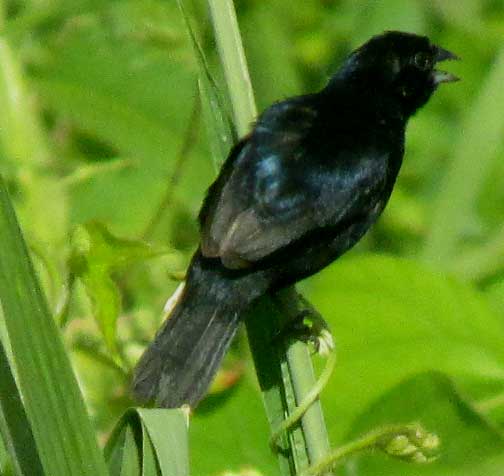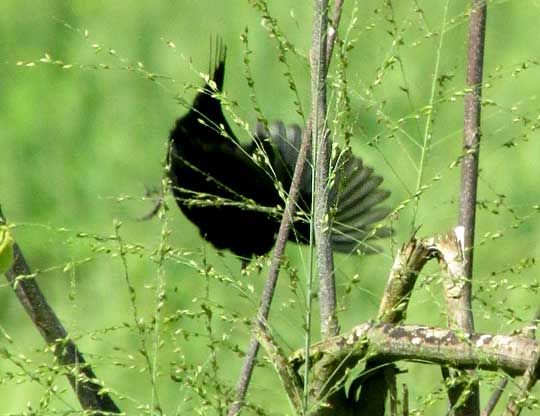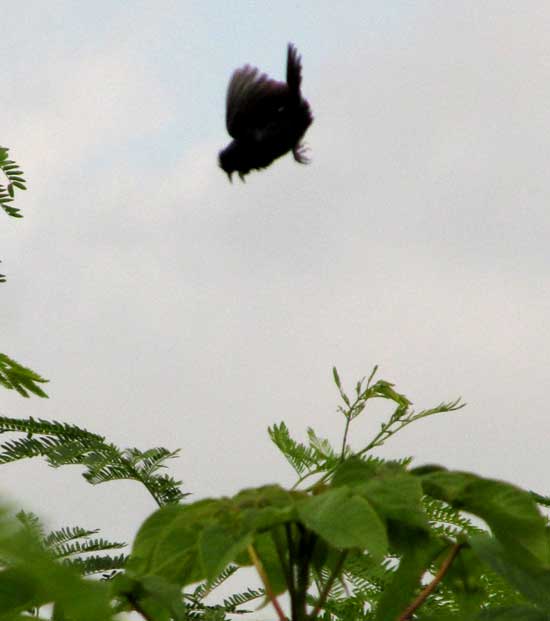Excerpts from Jim Conrad's
Naturalist Newsletter
from the September 6, 2015 Newsletter issued from Yuxunah, 20kms southwest of Chichén Intzá, Yucatán, MÉXICO
BLUE-BLACK GRASSQUIT
Around Yaxunah there's plenty of weedy land -- abandoned cornfields -- that's prime habitat for small, seed-eating birds such as finches and sparrows. In our area the most commonly seen species of this type is the Blue-black Grassquit, VOLATINIA JACARINA. Below, one is shown on a Switchgrass stem:

The bird in the picture has his beak open as if singing, but he isn't. I think he's just hot, cooling himself with moisture evaporating from his lungs. He's a male, females being brownish.
Male Blue-black Grassquits remind us of Indigo Buntings, but the male grassquit's indigo color merely appears as patches of mottling, not covering the whole body as with male Indigo Buntings. If you're in poor light wondering if the dark bird you're seeing might really be an Indigo Bunting, with shadowing causing the bird's blackness, male Blue-black Grassquits do something I've never seen other birds do: From their perches on conspicuous twigs or fences they suddenly fly straight up a foot or two, then just as suddenly return to their perches, maybe to the same spot or maybe nearby.
My books say that they do this as they make an inset-like buzz. Often I don't hear such a buzz, but I don't hear higher frequencies well. However, I certainly see them jumping, which occurs every 15 seconds or so when it's taking place. Jumping periods last or maybe 20-30 minutes, then they take a break.
I've wondered whether the jumps are to make the male birds more visible to other males who might invade the territory, or to impress females with their vigor, or maybe for both reasons. This week I got a photo showing that when the bird jumps he flies straight up and then dive-bombs back to his perch head-first, his tail pointing skyward. The camera caught one bird's incredible plummet earthward, seen below through some flowering panicles of Switchgrass:

That kind of acrobatics requires a strong, healthy body, so it can be imagined that such a dive would impress both males thinking of invading territory, and females looking for vigorous mates.
from the September 24, 2017 Newsletter issued from Rancho Regenesis in the woods ±4kms west of Ek Balam Ruins; elevation ~40m (~130 ft), N20.876°, W88.170°; north-central Yucatán, MÉXICO
CONFIRMING THE HEAD-FIRST DIVE
Above we see our bird returning to his perch in a head-first dive. Often I've tried to catch him in return flight again, to confirm that he habitually dives head-first. This week I got the picture -- the bird blurry as in the first case because he's plunging so fast -- as you can see below:
